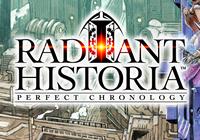Radiant Historia: Perfect Chronology (Nintendo 3DS) Second Opinion Review
By Rudy Lavaux  21.03.2018
21.03.2018

Time travel has been a fascinating subject for decades that has inspired countless stories from Jules Verne's own Time Machine book all the way to Back to the Future in cinemas in the 1980s. It comes as no surprise, therefore, that the topic has been touched upon more often than not in videogame form ever since the media has existed. Few, however, have ever managed to capture the attention of the public as much as Chrono Trigger did in the mid 1990s. Others have tried it, like the Prince of Persia titles of the 2000s, but as far as RPGs go, and Japanese RPGs in particular, few have ever managed to captivate as much as the original Radiant Historia did. The original on Nintendo DS received a glowing review back in the day and after an already thoroughly positive impression delivered by Cubed3 colleague Renan Fontes in both his preview and review, Cubed3 now delivers its second opinion review of the game.
The continent of Vainqueur is being swallowed, along with the rest of the world, by a phenomenon called the desertification, which, as its name suggests, sees every piece of fertile green land being turned into a lifeless desert. Teo and Lippti, two ethereal beings bearing the appearance of children, watch over time and space and cannot help but be saddened by the state the world is in and where it's headed at this rate, with war raging between nations of the continent, mainly between Granorg and Alistel, over the few remaining fertile lands capable of harbouring life. The two children will, therefore, guide Stocke, an Alistellian Secret Intelligence agent, on his quest to affect history and guide it towards the best possible outcome for himself and the people around him, the continent, and the world at large. Stocke becomes the wielder of the White Chronicle early on, a powerful artefact that grants its bearer the power to move through time, jumping back to previously experienced events to change their outcome using the knowledge acquired along the way, but also to jump between two alternate realities that each hinge on whether he remains an SI agent or not. The story told here is one of political and military plots, friendship, and even love at times, and decidedly takes on very sombre and serious tones geared perhaps more towards a teenage and adult audience than towards children, which in the world of JRPGs is not something often seen and even something worthy of applause.
It cannot be overstated that Radiant Historia was already at the time an extremely good game, the likes of which didn't have, and still doesn't have, anything to be envious of the likes of Chrono Trigger when it comes to telling a good story based on time travel. Both games were available on the Nintendo DS and even if it did not enjoy the same prestigious reputation that Squaresoft's classic did, at least it had the advantage of being a completely original title and not a port. The core experience here is largely identical to the original game. The engrossing grid-based battle system is back and still in place, and jumping around in time, experiencing events found in both timelines and changing things in one to affect the other is still as great and original an experience as it ever was seven years ago. Even if that was all there was to the game, the original was such an amazing experience that it would still be enough, however, that wouldn't be much of an incentive for those that already own the original to come back for more, even if perhaps the late limited release on the original DS, which did see at the very least a second print from Atlus USA, and the lack of a release in Europe at the time, severely limited its impact on the market.

Thankfully, a plethora of additions were added in to entice even owners of the original to dive back in. A few new nodes in the main original story, for instance, help make returning to some specific points in time a bit easier, without having to retrace too many steps to get to this one point where a side-quest obtained later can finally be completed, and so on, and so forth. The meat of the additions, though, is to be found in the new content - the new story elements. A few unfortunate outcomes of the original story can now be made right, although they do not affect the original ending, despite the fact that they take place before it. Instead, they affect a completely new ending beyond the original "best" ending. This one is unlocked by playing an entirely separate story arc centred round the character of Nemesia. It can either be played as the main story goes, by selecting the "Perfect" story mode upon creating a new save file, or be left inaccessible until the original ending has been reached by selecting the "Append" mode, which is more recommended to people who have never experienced Radiant Historia before. Indeed, a lot of the new missions to be received from Nemesia, which all take place in alternate realities, are in fact variations on events already experienced through the main story in both timelines and unlock as said events have been witnessed through the campaign. As a result, tackling both the old and new content may make the story extra convoluted and harder to take in for anyone who has not played it before, especially since the new ending cannot be reached until all of the old content has already been played anyway, so the option to leave that for later is welcome indeed. Selecting either mode can only be done upon starting and cannot be changed after the choice was made at the start, for consistency.
Sadly, for all of the new story content, barely any new locations have been added in, which kind of makes some of said events a bit redundant, but at least the different perspective offered by the "other possible worlds" add quite a bit of depth to an already deep story. One major new location has been added in, though, in the form of the Vault of Time, accessible from Historia itself. It allows the player to farm for "Mementos," a currency exclusive to that place, and trade them for completely new weapons, armour, accessories, items, and even some new support skills for all playable characters. Some of the best equipment in this new version of the game is only available here, so it is definitely worth investing time into.

Adding in some DLC stories, which only serve to shed some more light on the characters themselves, or putting them into funny situations with a heavy dose of fan service thrown in, this wraps up most of the immediately noticeable additions in terms of story content. Beyond that, however, new difficulty modes are now also present. The normal difficulty mode allows a player to replay a lost battle at the expense of a few mana crystals, the new hard mode steps up the difficulty considerably and removes battle retries altogether, while the new friendly mode does not exactly lower difficulty but gives infinite battle retries and lets Stocke despatch enemies on the field with one quick sword slash, allowing the player to skip every non-compulsory battle in the game to rather focus on enjoying the story itself, which perhaps is not the best way to enjoy the game the first time around, but, however, should make the next new element all the more enjoyable: "New Game+". This functionality, not present in the previous version, has now been added in, allowing one to use clear data to restart the adventure from the beginning, carrying over levels, stats, money, skills, mana bursts, all items excluding some story related valuables, and anything already unlocked in the vault of time and the newly added art gallery where character art and stills used throughout the story can be enjoyed at leisure. This is a welcomed addition indeed for anyone simply looking to replay through the story later on and enjoy the excellent plot.
These kinds of quality of life improvements are always welcome and show the dedication of the development team to making this experience as pleasant as possible. Some rather minor additions, for example, like an auto-play option, allow players to put the console down and grab a drink or some crisps while story scenes play out on their own, while the lower screen displaying the attacking order in battles now clearly displays what enemy is going to act next by showing their grid position next to their icon, which was a minor gripe with the original that is now no more. Everything that the original did, Perfect Chronology does it too, and even better, in fact! The only thing missing, which was not a big deal anyway, is touch screen controls on the field. The original allowed to tap a spot on the field on the touch screen and Stocke would move there, but this was only really useful in the absence of a Circle Pad, which the 3DS has now, so that is not regrettable in the slightest. Overall, Radiant Historia: Perfect Chronology feels more like an upgraded and expanded port of the original Nintendo DS game from 2011, rather than a full-on remake, and this is in no small part due to the almost identical visuals.

This is a 3DS game, and there is no stereoscopic 3D to be found in there, as has been the trend in the later years of the system's life. Not that it needed it to make the world within feel more real, but the fact that it already looks so similar to a 2011 DS game that already didn't take full advantage of the original system's capabilities makes the absence of 3D even more jarring as it was certainly not a matter of horsepower that kept the effect from being added in. Sprite-work looks absolutely identical to the original and 3D geometry doesn't seem to have been upgraded at all, either. Only the textures seem to use slightly higher resolution assets and, of course, the 3DS' better texture filtering and higher screen resolution make it all look a lot cleaner than before, making this version undeniably the best looking one and the definitive version of it going forward. Nevertheless, more of an overhaul would have been welcome. The character art, at least, has been completely revamped. Tri-Ace's Hiroshi Konishi of Radiata Stories fame had contributed all of the character art for the original, pouring a thoroughly unique art style into them, though, perhaps a bit eccentric in nature. This, however, is now all gone and replaced by new, brighter, maybe less unique but definitely more mainstream and widely appealing character art, courtesy of Masaki Hirooka. Some 2D artwork is also thrown in at key points in the story to illustrate certain scenes and enhance their presentation, which is a nice surprise.
The biggest addition in terms of presentation, however, is to be found in the sound department. Not only is the excellent soundtrack by Yoko Shimomura now played at a much better bit-rate or sampling rate, making it sound less muffled or compressed than it did on the old DS, but even better is the addition of voice acting. By and large, the voice cast does a decent job of adding weight to the otherwise rather expressionless and bland sprites. Coupled with the new character portraits that now display more than just one facial expression, this serves to elevate the narrative a lot more than the otherwise mild visual improvements present here. On a final note, the point of contention found with the original game that was the annoying sound of footsteps of the hero has been addressed and replaced with far more realistic sounding sound effects this time around that are not at all distracting like it could be before, so any worries on that front may be laid to rest immediately, for any potential double-dippers.

Cubed3 Rating
Exceptional - Gold Award

While its lack of a sizeable visual upgrade over the original is a regrettable thing, Radiant Historia: Perfect Chronology still packs more than enough qualities to rank it pretty high amongst the best JRPGs ever released. The older version was already arguably the best original DS RPG and this one, while not an original outing, shines as one of the best narratives to be experienced on the Nintendo 3DS in the genre, which is saying something when everyone knows how large its library has become. A plethora of additional events, improved sound quality, voice acting, and more quality of life improvements, make this new version unquestionably the definitive edition of an already great game and, despite its lack of massive visual improvement, it is still arguably one of the best titles of its genre on the platform that will sadly perhaps once again suffer from a very late release but at least this time, thanks to Deep Silver, European gamers are not left out, which would have been terrible on the region locked 3DS.

![]() 9/10
9/10
![]() 0
(0 Votes)
0
(0 Votes)
 Out now
Out now  Out now
Out now  Out now
Out now  Out now
Out now Comments
Comments are currently disabled

 Sign In
Sign In Game Details
Game Details Subscribe to this topic
Subscribe to this topic Features
Features







 Top
Top

